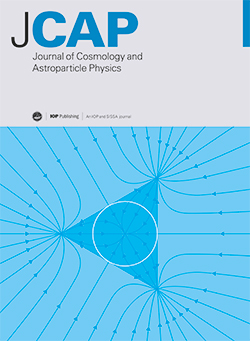Supernova gamma-ray constraints from heavy sterile neutrino decays
IF 5.9
2区 物理与天体物理
Q1 ASTRONOMY & ASTROPHYSICS
Journal of Cosmology and Astroparticle Physics
Pub Date : 2025-07-03
DOI:10.1088/1475-7516/2025/07/012
引用次数: 0
Abstract
Heavy sterile neutrinos can be produced in core-collapse supernovae (CCSNe), which are superb particle generators because of their high densities and temperatures. If the sterile neutrinos are long-lived, these may be produced inside the supernova core and escape the stellar envelope, later decaying into SM particles like photons and neutrinos. In this work, we first improve the original analytical calculation of the γ-ray fluxes from decays. We then revisit the bounds on the sterile neutrino parameter space from the non-observation of γ-rays from SN1987A by the Solar Maximum Mission (SMM) and constraints from the diffuse γ-ray background arising from sterile neutrino decays. We find that the constraints arising from both the SMM data and the diffuse γ-ray background are weaker than those that have previously appeared in the recent literature. Finally, we study the sensitivity of several present and near-future γ-ray telescopes such as e-ASTROGAM and Fermi-LAT, assuming a nearby future galactic CCSN. We show that future observations can probe mixing angles as low as |Uτ/μ4|2 ∼ 5 × 10-17.来自重惰性中微子衰变的超新星伽马射线约束
重惰性中微子可以在核心坍缩超新星(CCSNe)中产生,由于它们的高密度和高温,它们是极好的粒子发生器。如果无菌中微子的寿命很长,它们可能在超新星的核心内部产生,并逃离恒星的外壳,随后衰变成像光子和中微子这样的SM粒子。在这项工作中,我们首先改进了原始的衰变γ射线通量的解析计算。然后,我们从太阳极大期任务(SMM)未观测到SN1987A的γ射线中重新讨论了无菌中微子参数空间的边界,以及由无菌中微子衰变引起的漫射γ射线背景的约束。我们发现SMM数据和漫射γ射线背景所产生的约束比以前在最近文献中出现的约束要弱。最后,我们研究了几种目前和近期的γ射线望远镜(如e-ASTROGAM和Fermi-LAT)的灵敏度,假设在不远的未来有一个星系CCSN。我们表明,未来的观测可以探测低至|Uτ/μ4|2 ~ 5 × 10-17的混合角。
本文章由计算机程序翻译,如有差异,请以英文原文为准。
求助全文
约1分钟内获得全文
求助全文
来源期刊

Journal of Cosmology and Astroparticle Physics
地学天文-天文与天体物理
CiteScore
10.20
自引率
23.40%
发文量
632
审稿时长
1 months
期刊介绍:
Journal of Cosmology and Astroparticle Physics (JCAP) encompasses theoretical, observational and experimental areas as well as computation and simulation. The journal covers the latest developments in the theory of all fundamental interactions and their cosmological implications (e.g. M-theory and cosmology, brane cosmology). JCAP''s coverage also includes topics such as formation, dynamics and clustering of galaxies, pre-galactic star formation, x-ray astronomy, radio astronomy, gravitational lensing, active galactic nuclei, intergalactic and interstellar matter.
 求助内容:
求助内容: 应助结果提醒方式:
应助结果提醒方式:


